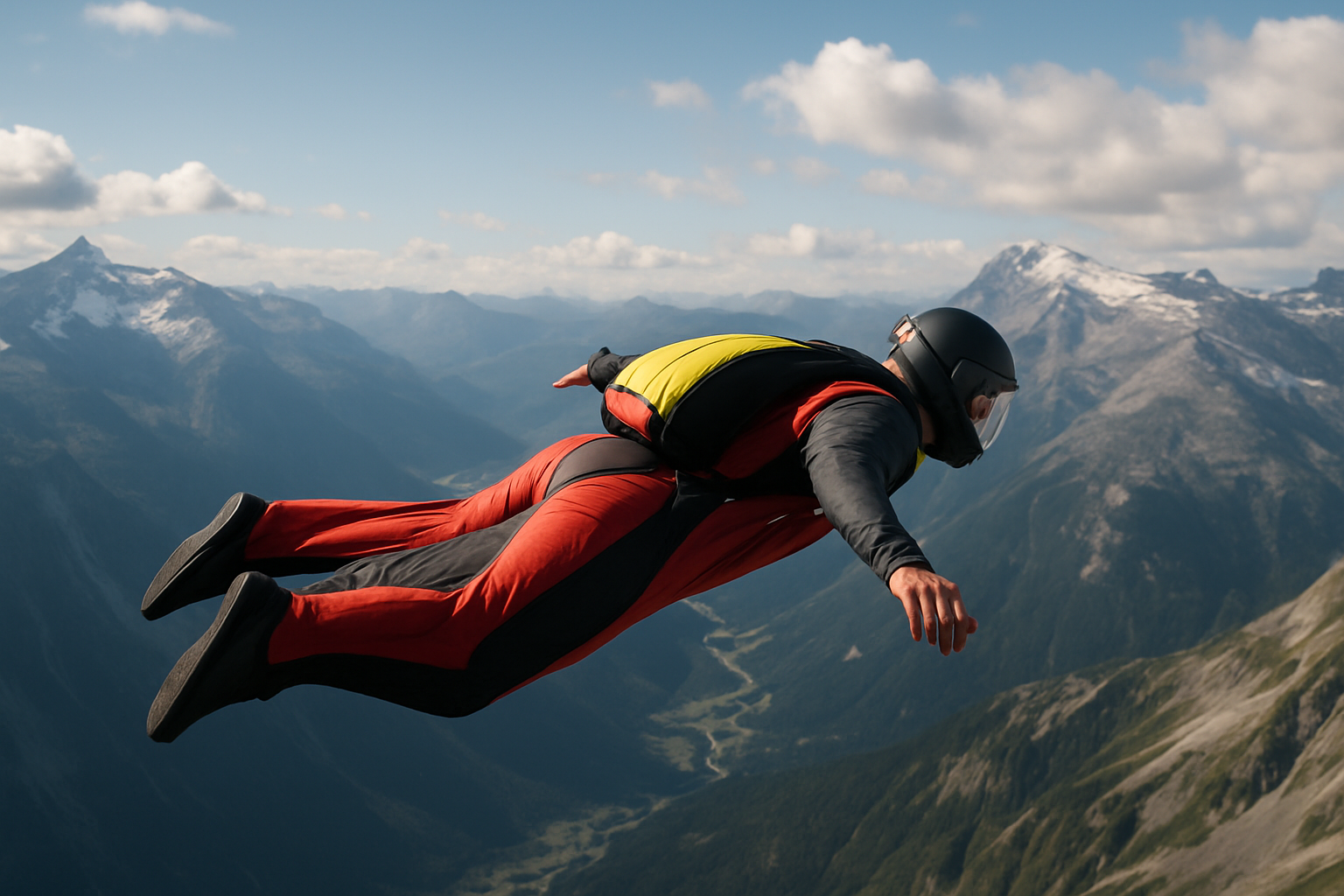Wingsuit Proximity Flying: The Ultimate Aerial Extreme Sport
Soaring through mountain valleys at breakneck speeds, mere meters from jagged rock faces, wingsuit proximity flyers push the boundaries of human flight. This adrenaline-fueled discipline combines cutting-edge technology with raw courage, challenging athletes to navigate treacherous terrain while harnessing the power of gravity and wind. As the sport evolves, it continues to captivate thrill-seekers and spectators alike, redefining our understanding of human potential in the air.

Pioneers like Jeb Corliss and Loïc Jean-Albert pushed the limits of what was possible, flying dangerously close to mountains, cliffs, and even man-made structures. Their daring feats, captured on video and shared globally, sparked both awe and controversy. The sport quickly gained a reputation as one of the most dangerous and visually spectacular extreme pursuits in the world.
The Science Behind the Flight
At its core, wingsuit proximity flying relies on the principles of aerodynamics. The specially designed suits create an airfoil shape when inflated, generating lift and allowing the flyer to glide through the air at a much shallower angle than a traditional skydiver. This increased glide ratio, often reaching 3:1 or higher, enables longer flights and more precise control over trajectory.
The physics of proximity flying are complex, involving a delicate balance of forces. As flyers navigate close to terrain, they must constantly adjust their body position to account for changes in air currents, updrafts, and potential obstacles. The margin for error is minuscule, with even slight miscalculations potentially leading to catastrophic consequences.
Recent advancements in suit design have focused on improving stability and control at high speeds. Some modern wingsuits incorporate additional fabric panels or “webbing” between the arms and legs, increasing surface area and lift. These innovations have allowed skilled flyers to achieve speeds of over 200 mph (320 km/h) while maintaining precise control.
Training and Preparation: A Methodical Approach to Extreme Risk
Becoming a proficient wingsuit proximity flyer requires years of dedicated training and a methodical approach to skill development. Most practitioners begin with traditional skydiving, accumulating hundreds or even thousands of jumps before transitioning to wingsuit flight. This foundation is crucial for developing spatial awareness, body control, and emergency procedures.
Once comfortable with basic wingsuit flight, aspiring proximity flyers gradually progress to more challenging environments. This often involves a series of carefully planned jumps, starting with wide, open valleys and slowly working towards narrower, more technical routes. Throughout this process, mental preparation is just as important as physical skill.
Visualization techniques play a significant role in training. Many flyers spend hours studying video footage of their intended flight paths, mentally rehearsing every movement and potential scenario. Some utilize virtual reality simulations to familiarize themselves with the terrain and practice decision-making in a safe environment.
Physical fitness is another critical aspect of preparation. Wingsuit flyers must maintain excellent core strength, flexibility, and cardiovascular endurance to withstand the intense forces experienced during flight and to react quickly to changing conditions. Many incorporate specialized strength training and yoga into their routines to enhance body awareness and control.
The Psychology of Extreme Risk
Wingsuit proximity flying stands out even among extreme sports for its level of inherent danger. The psychological profile of those drawn to this discipline is a subject of fascination for researchers in sports psychology and risk behavior.
Studies have shown that many proximity flyers exhibit traits such as high sensation-seeking tendencies, low anxiety levels, and a strong internal locus of control. These characteristics enable them to manage the intense stress and fear associated with such high-stakes activities.
However, the psychology of the sport goes beyond individual personality traits. The tight-knit community of wingsuit flyers often develops a unique culture and set of norms around risk management. This can sometimes lead to a phenomenon known as “normalization of deviance,” where increasingly risky behaviors become accepted as standard practice.
Balancing the pursuit of progression with responsible risk management is an ongoing challenge for the sport. Many experienced flyers emphasize the importance of mentorship and gradual skill development to counteract the potential for overconfidence or reckless behavior among newcomers.
Technical Innovations and Safety Measures
As wingsuit proximity flying has evolved, so too have the technologies and safety measures associated with it. Modern wingsuits are marvels of engineering, incorporating advanced materials and design features to enhance performance and safety.
One significant innovation has been the development of emergency parachute systems specifically designed for wingsuit flight. These systems are optimized for rapid deployment at high speeds and in unusual body positions, providing a critical last line of defense in emergency situations.
GPS and altimeter technology have also become more sophisticated, allowing flyers to track their speed, altitude, and glide ratio with greater precision. Some cutting-edge suits even incorporate heads-up displays in the helmet, providing real-time flight data without requiring the pilot to look away from their flight path.
Despite these advancements, the inherent risks of proximity flying remain high. The sport continues to see fatalities each year, often involving even highly experienced practitioners. This has led to ongoing debates within the community about the balance between progression and safety, and whether certain types of flights or locations should be restricted.
The Environmental and Ethical Considerations
As wingsuit proximity flying has gained popularity, it has also faced increasing scrutiny regarding its environmental impact and ethical implications. The sport often takes place in pristine natural environments, raising concerns about potential disturbance to wildlife and ecosystems.
Some popular flying locations have implemented regulations to mitigate these impacts, such as limiting the number of jumps allowed per day or designating specific flight paths to avoid sensitive areas. However, enforcement of such measures can be challenging in remote mountain regions.
The visual spectacle of proximity flying has also led to its use in commercial advertising and film production. While this has brought increased attention and resources to the sport, it has also raised questions about the potential glorification of extreme risk-taking and the ethical responsibilities of media producers.
Additionally, the high-profile nature of some proximity flying accidents has led to debates about the allocation of search and rescue resources in remote areas. Some argue that the sport places an undue burden on local emergency services, while others contend that proximity flyers bring valuable tourism and attention to these regions.
The Future of Wingsuit Proximity Flying
As wingsuit technology continues to advance and new generations of flyers push the boundaries of what’s possible, the future of proximity flying remains both exciting and uncertain. Some envision a world where augmented reality systems could provide real-time guidance and hazard detection, potentially reducing the risks associated with the sport.
Others speculate about the potential for wingsuit racing leagues or standardized competitive formats, which could bring the sport to a wider audience while providing a more controlled environment for progression. However, such developments would need to carefully balance the spirit of adventure and exploration that draws many to proximity flying with the need for safety and regulation.
The ongoing evolution of materials science may lead to even more efficient wingsuit designs, potentially allowing for longer flights and more precise control. Some researchers are exploring biomimetic approaches, drawing inspiration from natural flyers like flying squirrels to inform suit design.
As virtual reality technology improves, it may play an increasingly important role in training and preparation for proximity flying. Advanced simulations could allow pilots to practice complex routes and scenarios with unprecedented realism, potentially reducing the risks associated with on-site progression.
The Cultural Impact and Media Representation
Wingsuit proximity flying has captured the public imagination in a way few other extreme sports have managed. Its visually stunning nature and the clear element of mortal risk have made it a favorite subject for documentaries, viral videos, and even Hollywood blockbusters.
This media attention has had a complex impact on the sport and its practitioners. On one hand, it has brought increased resources and opportunities for professional flyers, allowing some to make a living from their passion. The exposure has also inspired countless individuals to pursue skydiving and other forms of aerial sports, contributing to the growth of the broader community.
However, the sensationalized portrayal of proximity flying in some media has also been a source of concern within the community. There are fears that the focus on the most extreme and dangerous aspects of the sport could encourage reckless behavior among newcomers or give the public a skewed perception of the discipline’s true nature.
Many experienced flyers emphasize that the most rewarding aspects of proximity flying are not captured in brief video clips or dramatic movie scenes. They speak of the intense focus and presence required, the deep connection with the natural environment, and the sense of flow achieved during a well-executed flight.
The Philosophical Dimensions of Human Flight
Beyond its technical and cultural aspects, wingsuit proximity flying raises profound philosophical questions about the nature of human experience and our relationship with risk and mortality. For many practitioners, the sport represents a unique form of engagement with the world, one that challenges conventional notions of human limitations and possibilities.
The act of flying so close to solid objects at such high speeds creates a state of hyper-awareness that some describe as transcendent. Many flyers report experiencing altered perceptions of time and self during their flights, echoing descriptions of “flow states” studied in positive psychology.
This intense form of embodied experience contrasts sharply with many aspects of modern life, which are increasingly mediated through screens and digital interfaces. In this context, proximity flying can be seen as a radical assertion of direct, physical engagement with the world.
The willingness of flyers to accept such high levels of risk also prompts reflection on the value of safety versus experience in human life. While few would argue that proximity flying is “safe” in any conventional sense, its practitioners often speak of the profound meaning and purpose they derive from the activity.
This tension between risk and reward, between the pursuit of intense experience and the preservation of life, is at the heart of many debates surrounding extreme sports. Wingsuit proximity flying, with its unparalleled combination of beauty, skill, and danger, serves as a powerful lens through which to examine these fundamental human questions.
A Testament to Human Potential and Complexity
Wingsuit proximity flying stands as one of the most extreme and awe-inspiring human activities ever conceived. It represents a unique confluence of technological innovation, physical skill, psychological fortitude, and a deep desire to push the boundaries of what is possible.
As the sport continues to evolve, it will likely remain a source of both inspiration and controversy. The quest for ever more spectacular flights must be balanced against the very real risks involved and the broader impacts on environments and communities.
Ultimately, wingsuit proximity flying serves as a powerful reminder of the complexity of human nature. It showcases our capacity for courage, creativity, and the pursuit of transcendent experiences, while also highlighting the eternal tension between our dreams of flight and the inescapable pull of gravity. As long as there are individuals willing to don wingsuits and leap from mountain peaks, this extraordinary discipline will continue to captivate and challenge our understanding of what it means to be human.





